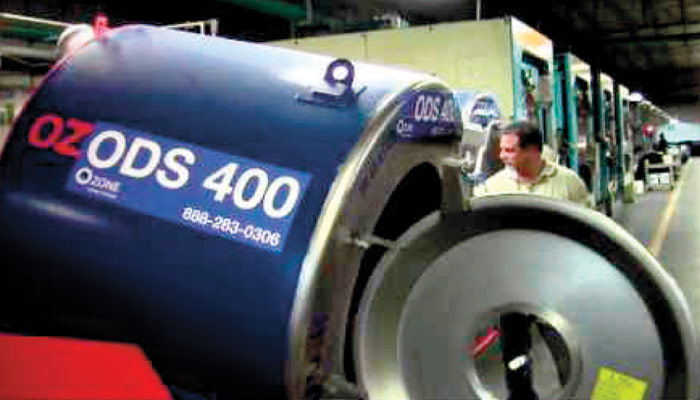The innovation of new machineries to support sustainability endeavours
Sustainability-driven innovation goes beyond designing green products and synthetic process methods. It entails improving business operations and processes to become more efficient, with a goal of dramatically reducing costs and waste. It is also about insulating a business from the risk of resource price shocks and other competitive business advantages. At every stage of the textile production, vast amount of energy, clean water & chemicals are being used to process the textiles & apparels. In turn these processes generate air, water & soil pollution through untreated effluent generation & waste generation which place heavy burden on environment. So, it was indeed a need of looking other ways of innovations attributed to garment finishes.
Technological upgrading of processing equipment or innovating new machines are the keys to achieve sustainable textile production and so remain competitive. Some of remarkable innovations in technology have paved the way for sustainable production technologies, but there is huge scope further for all technology providers to upgrade technology which will help in economical production of the goods in sustainable manner!
But these Innovations require a new way of thinking. We must learn to think out of the box. Things invented else where that we have stripped down, made more affordable, replicable and more relevant to our conditions with great adroitness. This will certainly be detrimental and hamper the creation of sustainable and ebullient fashion industry. I would like to emphasis few products having serious flaws which are made qua fashion industry.
Ozone finishing machines for denim garment
Companies considering investment in ozone technology should consider three factors: Safety, quality, and performance. Proper ozone bleaching systems are comprised of:
• Filtered/refrigerated air compressor
• Oxygen concentrator
• Ozone generator
• Exposure chamber
• Ozone destruction unit
Certain countries have robust and enduring norms to prevent the spillage of ozone gas, which is one of the most corrosive and dangerous gas to inhale for any life. Most of the cost associated with manufacturing will go for the safety side rather than the core machine functioning parts. Obviously almost 40 to 70 per cent of the cost of machine will be invested on the safety side as life’s involved around.
The same product have been noticed, copied by machine manufactures mainly from Turkey and Asian region more focusing on the performance side and least on the safety for the drastic reduction in cost and presented with greatest aplomb. Can’t imagine the atrocities and it is really appalling! There is a perpetual imbalance created in supply chain with in the norms, found as the inherent weakness of the current architecture of sustainability and the overarching dependency of it will be hurtling us towards a very interesting disaster.
The Canadian Government reports exposure to ozone at 0.1 parts per mn (ppm) causes minor irritation to the eyes, nose and throat and may cause headaches; at 50 ppm, death can be expected. For bleaching denim, 5,000 – 7,000 ppm are used. Exposure to ozone can be deadly. The United States Occupational Safety and Health Administration (OSHA) standards set maximum allowable exposure of workers operating ozone technology in the US at 0.1 ppm per 8 hours, time weighted average7 and 0.3 ppm per 15 minutes. Ozone Safe Works Practices document also states ozone corrodes most metals, damages most plastics, and hardens rubber (causing it to crack). Ozone bleaching equipment (including seals and gaskets) must be designed and constructed with materials that withstand these effects in order to reduce the potential for accidental exposure.
To prevent harmful or deadly accidental exposure of workers to ozone gas, safety features and safety practices should be of paramount importance in selecting, installing, operating, and maintaining ozone finishing equipment in any facility.
While certain manufactures sell ozone equipment for the jeans industry, safety features vary in important ways, leaving some workers potentially more at risk than others for accidental ozone exposure. The induction of these systems in the denim processing is very detrimental – as the standard of machine manufactures and awareness of safe handling and usage of machine is a question mark. The exposure of this gas is to too toxic and corrosive than any chemical usage. There are safest substitutes with innocuous chemicals to have these finishes, saves life risk, energy and productivity.
E –Flow Machines
 These are machines made to address sustainability by the drastic reduction of water, by vaporizing chemicals in to Nano molecular mist. The same is in the case of chemical vaporizing machines or E – Flow machines. Let’s assume the products of Europe have the exposure norms, but the economical machine’s manufactured in other regions pose a major life threat. The hazardous chemical vapour exposure can straight lead to Sudden Cardiac Arrest (SCA) or cardio vascular dieses (CVD).
These are machines made to address sustainability by the drastic reduction of water, by vaporizing chemicals in to Nano molecular mist. The same is in the case of chemical vaporizing machines or E – Flow machines. Let’s assume the products of Europe have the exposure norms, but the economical machine’s manufactured in other regions pose a major life threat. The hazardous chemical vapour exposure can straight lead to Sudden Cardiac Arrest (SCA) or cardio vascular dieses (CVD).
Such machines are easily available and industry found it more affordable and has a snob value to woo the buyers. Even the normal PPE masks cannot protect those who exposes and the vicissitudes are well known.
Today, we have decent system hampered by the structure of it and it is a fatal weakness. My contention is validation of existing agencies as an absolute term must never exist as an option for perpetrating the sustainability drive in its entire means. The overarching dependency of it inevitably disastrous. The flaws must be identified and must work for a course correction with the domain for enduring positive changes.
Sustainable and responsible management to build and vibrant and ebullient fashion industry to surge ahead
Sustainability management and responsibility taking must be long term and learning oriented. Sustainability and responsibility for sustainability will always be contested. Research has an important role to play here in identifying strengths and weaknesses in present-day practice and offering suggestions about pathways forward. The precise environmental impact of textiles varies significantly depending on the type of fibre the garment is made from. However, generally speaking they include,
• Energy use, Greenhouse Gas (GHG) emissions, nutrients releases (leading to eutrophication) and Eco toxicity from washing (water heating and detergents) and dyeing of textiles
• Energy use, resource depletion and GHG emissions from processing fossil fuels into synthetic fibres. E.g. Polyester or Nylon
• Significant water use, toxicity from fertilizer, pesticide and herbicide use, energy use and GHG emissions associated with fertilizer generation and irrigation systems related to production of fibre crops, e.g. cotton
• Water use, toxicity, hazardous waste and effluent associated with the production stage, including pre-treatment chemicals, dyes and finishes.
‘Look good and feel good’ fashion wears
By improving their environmental and social performances, brands can improve their reputation. Linking business to social and environmental projects enables companies to build a strong connection with consumers by involving them in sustainability initiatives.Technological innovation in production processes, along the supply chain, which contribute to improve the environmental footprint of processes and which may save costs, enabling the use of more recycled materials.
Traceability and Ethical values: Complex and global value chains often with low traceability represent an obstacle for producers and brands who want to improve their production patterns. Certain incertitude like socially and environmentally friendlier textiles might result in more expensive finished products.The perception of some consumers that sustainable garments are not stylish or fashionable, and that the design and the appearance of eco-clothing is unfashionable and unattractive.
Developing production processes using lower amounts of water, pesticides, insecticides, hazardous chemicals or lower releases of GHG etc. is as important as the measures adopted by retailers and consumers to select such textiles. However, consumer behaviour in how they care for and dispose of clothing and other textile products is of equal importance, e.g. selecting the appropriate washing temperatures, taking the right steps to significantly extend the lifetimes and encouraging recycling of garments once they have reached their end of life. These important issues are all areas where retailers can have a high degree of influence.
Economical options with deep ecological impact
• Continuing to improve the working and social conditions of workers, while offering textiles at an affordable price for consumers whose purchasing power is declining
• Improving the overall environmental footprint of textiles over their entire lifecycle and supply chain
• Changing consumer attitudes of buying as cheap as possible and as many as possible
• Providing consumers with relevant information concerning the environmental foot print of the textile products, based on harmonized systems
From retailer’s edge to supports sustainable fashion wear
• Offer and promote more environmentally friendlier textiles
• Demand more environmental and social accountability from producers
• Communicate to consumers the added value of sustainability and inform them on more environmentally friendly behaviour e.g. encouraging the most efficient wash cycle programs, process amalgamation, lower temperatures etc. and how this can help them save money on energy bills and reduce water usage thus lowering overall environmental footprint and process cost
• Encourage recycling of garments, promoting locally provided clothes banks/ bins, etc.
• For retailers who provide employees with working clothes, revert to more socially and environmentally friendlier textiles
• Include sustainability issue in staff training.
Sustainability drive to be initiated by textile manufactures
• Source their suppliers based on their social and environmental performances
• Use best practices in technological innovation which contribute to improve the environmental footprint of processes
• Substitute hazardous substances with safer substances
• Increase information exchange with retailers, provide them with information about the latest innovative solutions that help them address their sustainability challenges/objectives.
• Develop and offer more environmentally friendlier textiles
• Promote the use of more sustainable fibres like organic cotton, recycled fibres etc.
• Engage in research about new fibres and materials with lower environmental impacts compared to natural fibres
• Improve care labels on products, and together with retailers increase focus on consumer communication to promote responsible care
• Encourage the reuse/recycling of old clothes and textiles to produce new clothes, rather than using raw materials, promote remanufacturing and fashion upgrades
• Communicate to consumers their sustainability efforts
• Demand their suppliers to implement international social standards.
Surge ahead with sustainable fashions and create trousseau value or feel good garments
• Launch and further promote collaborative initiatives to improve the environmental performance of textiles across the supply chain (sustainable design, fibres and fabrics, maximize reuse/recycling/end-of-life-management, sustainable cleaning)
• Start awareness raising campaigns and sharing of experiences in textile processing regions
• Manufacturers (clothing, fabrics, chemicals ,etc.), retailers, consumer groups, etc. should carry out campaigns and inform consumers on issues of common interest related to sustainable fashion consumption and work with designers, celebrities and NGOs to help spread the messages on how to be more environmentally friendly, e.g. reducing the temperatures of the wash cycle, etc.
The textile industry is characterized by high competitive pressure and globally fragmented supply chains. Thus, all case companies have emphasized the importance of competitive pressure as an external barrier for SSCM policy implementation. Close buyer-supplier collaboration is essential to diminish the barriers to successful policy implementation within the highly competitive an ebullient textile industry



















